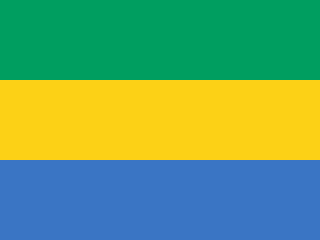
Gabon, officially the Gabonese Republic, is a country on the west coast of Central Africa. Located on the equator, Gabon is bordered by Equatorial Guinea to the northwest, Cameroon to the north, the Republic of the Congo on the east and south, and the Gulf of Guinea to the west. It has an area of nearly 270,000 square kilometres (100,000 sq mi) and its population is estimated at 2.1 million people. There are three distinct regions: the coastal plains, the mountains, and the savanna in the east. Gabon's capital and largest city is Libreville. The official language is French.
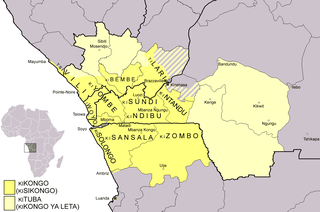
Kongo or Kikongo is one of the Bantu languages spoken by the Kongo people living in the Democratic Republic of the Congo, the Republic of the Congo, Angola and Gabon. It is a tonal language. It was spoken by many of those who were taken from the region and sold as slaves in the Americas. For this reason, while Kongo still is spoken in the above-mentioned countries, creolized forms of the language are found in ritual speech of Afro-American religions, especially in Brazil, Cuba, Puerto Rico, Dominican Republic and Haiti. It is also one of the sources of the Gullah language and the Palenquero creole in Colombia. The vast majority of present-day speakers live in Africa. There are roughly seven million native speakers of Kongo, with perhaps two million more who use it as a second language.
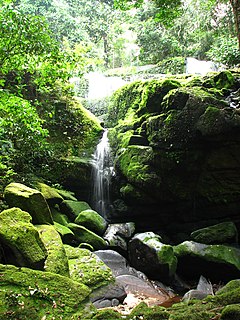
Ogooué-Ivindo Province is the northeasternmost of Gabon's nine provinces, though its Lopé Department is in the very center of the country. It gets its name from two rivers, the Ogooué and the Ivindo. This province, containing thousands of square kilometres of rainforest, is the largest and most sparsely populated and much less developed than the rest of the country. As of 2013 it had a population of 63,293 people. The principal town is Makokou.

The Kongo people are a Bantu ethnic group primarily defined as the speakers of Kikongo.
Kota or KOTA may refer to:
The Ekang are a group of closely related Bantu ethnic groups located in rain forest regions of Cameroon, Republic of the Congo, Equatorial Guinea, Gabon, and São Tomé and Príncipe. Though they separate themselves into several individual clans, they all share a common origin, history and culture.
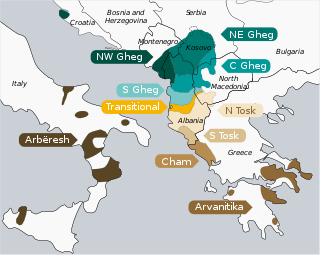
Gheg is one of the two major varieties of Albanian, the other being Tosk. The geographic dividing line between the two varieties is the Shkumbin River, which winds its way through central Albania. Gheg is spoken in northern and central Albania, Kosovo, northwestern North Macedonia, southeastern Montenegro and southern Serbia by the Albanian dialectal subgroup known as Ghegs.

The Fang people, also known as Fãn or Pahouin, are a Bantu ethnic group found in Equatorial Guinea, northern Gabon, and southern Cameroon. Representing about 85% of the total population of Equatorial Guinea, concentrated in the Río Muni region, the Fang people are its largest ethnic group. The Fang are also the largest ethnic group in Gabon, making up about a quarter of the population. In other countries, in the regions they live, they are one of the most significant and influential ethnic groups.
Dhundhari is a dialect of Rajasthani spoken in the Dhundhar region of northeastern Rajasthan state, India. Dhundari-speaking people are found in four districts – Jaipur, Sawai Madhopur, Dausa, Tonk and some parts of Sikar

There are over 525 native languages spoken in Nigeria. The official language of Nigeria is English, the language of former colonial British Nigeria. As reported in 2003, Nigerian English and Nigerian Pidgin were spoken as a second language by 100 million people in Nigeria. Communication in the English language is much more popular in the country's urban communities than it is in the rural areas, due to globalization.

Most African sculpture was historically in wood and other organic materials that have not survived from earlier than at most a few centuries ago; older pottery figures are found from a number of areas. Masks are important elements in the art of many peoples, along with human figures, often highly stylized. There is a vast variety of styles, often varying within the same context of origin depending on the use of the object, but wide regional trends are apparent; sculpture is most common among "groups of settled cultivators in the areas drained by the Niger and Congo rivers" in West Africa. Direct images of African deities are relatively infrequent, but masks in particular are or were often made for traditional African religious ceremonies; today many are made for tourists as "airport art". African masks were an influence on European Modernist art, which was inspired by their lack of concern for naturalistic depiction.
Beti is a group of Bantu languages, spoken by the Beti-Pahuin peoples who inhabit the rain forest regions of Cameroon, Republic of the Congo, Equatorial Guinea, Gabon, and São Tomé and Príncipe. The varieties, which are largely mutually intelligible and variously considered dialects or closely related languages, are:

Minkébé National Park is a national park in the extreme northeast of Gabon. It covers an area of 7,570 km2. The WWF recognized it as an area needing protection as early as 1989 and has been actively working towards protecting the forest since 1997. The park was established as a provisional reserve in 2000 but the Minkébé National Park itself was officially recognized and established by the Gabonese government in August 2002. It is recognized as a critical site for conservation by the IUCN and has been proposed as a World Heritage Site.
The Gabonese people have forged since the independence of the country, in 1960, their own culture which is neither the traditional culture of the different ethnic groups which compose it, nor modern Western culture. It is a culture in movement, a mixture of diversity and common traits, bringing together the most diverse beliefs and practices.
Kota, or iKota, is an Bantu language spoken by the Bakota people. It is spoken in northeastern Gabon, Ogooué-Ivindo Province and in some areas of Republic of Congo. According to Ethnologue there are 34,442 Kota speakers in Gabon and 9,055 in the Republic of Congo.

Franck Emmanuel Issoze-Ngondet was a Gabonese diplomat and politician who served as Prime Minister of Gabon from 2016 to 2019.
Aka, also known as Yaka or Beka, is a Bantu language spoken in the Central African Republic and Republic of Congo, along the Ubangi River dividing the two countries.
Baka is a dialect cluster of Ubangian languages spoken by the Baka Pygmies of Cameroon and Gabon. The people are ethnically close to the Aka, the two together called the Mbenga (Bambenga), but the languages are not related, apart from some vocabulary dealing with the forest economy, which suggests the Aka may have shifted to Bantu, probably 15000 people have shifted.
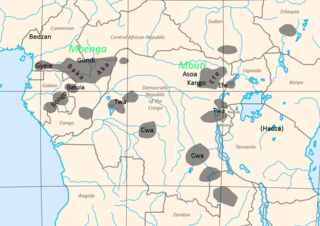
The Congo Pygmies are those "forest people" who have, or recently had, a hunter-gatherer economy and a simple, non-hierarchical societal structure based on bands, are of short stature, have a deep cultural and religious affinity with the Congo forest and live in a generally subservient relationship with agricultural "patrons", with which they trade forest products such as meat and honey for agricultural and iron products.
The Emishi, written with Chinese characters that literally mean "shrimp barbarians," constituted an ancient ethnic group of people who lived in parts of Honshū, especially in the Tōhoku region, referred to as michi no oku in contemporary sources.












